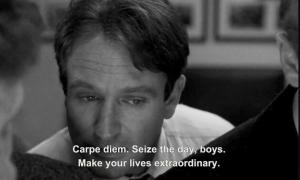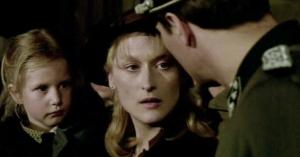Expressionism: characteristics, works and authors
Expressionism was an artistic, cinematographic, musical, and literary movement that began as a pictorial style in Germany during the transition from the 19th to the 20th century. She then expanded to other disciplines and regions until she reached maturity between 1905 and 1933, leaving out the interruption that the First World War meant. Unlike the so-called historical avant-gardes, Expressionism was not a movement with a unified style. It was rather the result of a critical spirit towards the new Western order.
Disappointment and criticism led this movement to have as the center of its program the pessimistic perception of life and contemporary individuals, the rejection of premeditated composition and the questioning of Apollonian beauty as the ultimate goal of the work artistic.

In this article we will learn about the characteristics of expressionism, both general and specific according to the discipline. Likewise, we will know the most important aspects of its context and origin, and the role played by the different groups attached to this aesthetic.
General characteristics of expressionism
Let us know some of the main characteristics of the aesthetics of expressionism in the following sections.
Negative perspective on reality

Expressionism is characterized by a disenchanted perspective on reality. Artists view the progressive promises of modernity with disbelief and distrust as they grasp the underlying contradictions.
Perceive the powerless subject in front of the threads of power
The expressionist generation conceives the individual as a being at the mercy of events, lacking its own substance and subjected to mediocrity. For this generation, people have been robbed of freedom and autonomy, and reduced to pieces of the system.
Represents the essence of the contemporary individual

Expressionism wishes to represent the essence of the contemporary individual. Therefore, he rejects the mere representation of appearances. Cultivate, thus, drama, subjectivity and the expression of human feelings, especially disappointment, terror, anguish, loneliness, human misery, dispossession and unbelief.
Predominance of instinct over rationality
Expressionism aims to make instinct prevail over rationality in creative processes. That is, the artist opposes deliberately rational composition and promotes the value of intuition and improvisation. The abrupt makes presence.
Strip objects of idealizations
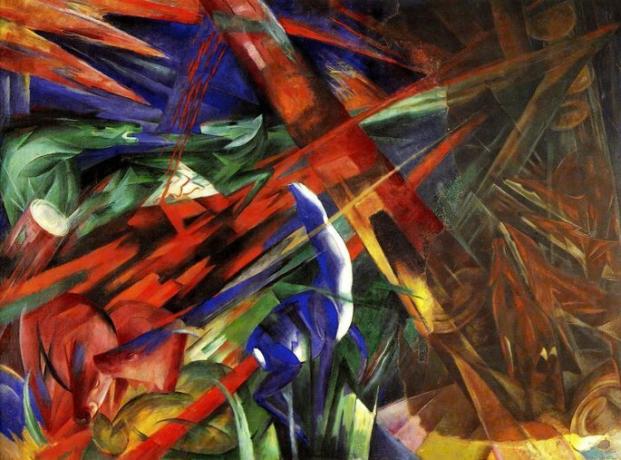
Subtracting objects from any idealization or any objectification is part of the expressionist principles. The represented universe always embodies an underlying reality.
Mastery of the psychological
The psychological plays a fundamental role, since it investigates the primary or instinctive feelings of the subjects, the dream world and the universe of the grotesque. It favors the distortion and tension between reality and what is perceived in the work.
Characteristics of expressionism by discipline
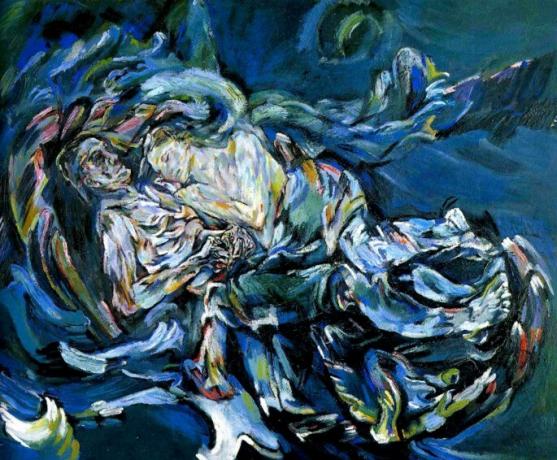
Characteristics of the plastic arts
- Preference for angular shapes;
- Use of the non-natural perspective, that is, arbitrary (according to the objectives of the representation);
- The figure is deformed to highlight the feeling;
- Construction of the oblique space;
- Scene overlay;
- Expressive coloring. Well resplendent colors (vibrant, well melted or separated), well pathetic colors;
- Thick, hammered, rough paste;
- Violent technique that goes to improvisation.
Characteristics of German expressionist cinema
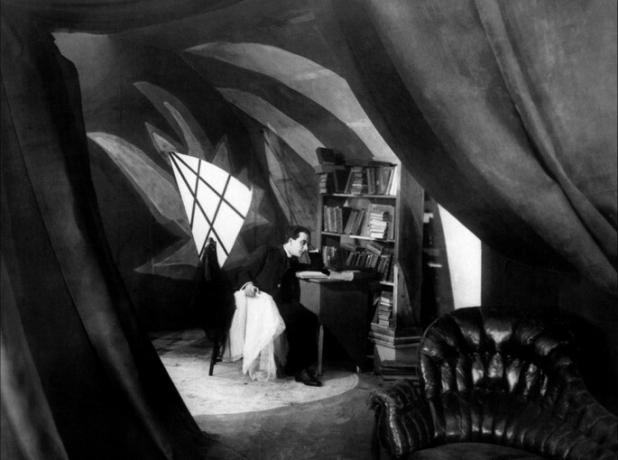
The end of the First World War also brought with it the development of a new cinematic aesthetic. The expressionist cinema also reflected the instability, the anguish, the ambiguity and the existential doubt of the German society. Expressionism reached an important cinematographic development in the 1920s and until the rise of the Nazis to power. Among its characteristics we can mention:
- Preference for the oval construction of the space, which accentuates the feeling of oppression and vigilance;
- Depth of field achieved with the decorations (unnaturalist character);
- Oblique planes that induce vertigo;
- Use of dimming light;
- Intense chiaroscuro as an expression of the duality of the individual confronted with his inner world;
- Recurring use of Very Close-up (DPI).
Characteristics of the literature

For some authors, literary expressionism is not perceived as a programmatic movement but as the spirit of a generation or an era. Still, you can distinguish some of the following characteristics.
- Extensive development of the novel and the theater especially;
- In narrative, two tendencies developed: one naturalistic and the other experimental;
- In poetry, space was given to an aesthetic of the grotesque and the renunciation of certain formal norms in favor of expression;
- In dramaturgy, figures often do not have individualized names but respond to type designations;
- He is not concerned with verisimilitude but with the expression of the inner world of subjects in permanent tension.
He may also interest you: Literary avant-garde
Music Features
Music, for its part, experienced an important turning point from the work of composers such as Arnold Schoenberg around 1918, Anton Webern and Alban Berg. All sought to overcome the conventions of the past, in search of a new way to build the aesthetic sense of music.
- Provides the twelve-tone system, that is to say, the scale made up of 12 sounds of the same interval that breaks with the structure of the western scale (based on 8 sounds);
- Promotes the development of atonal music;
- He goes to extremely dissonant harmonizations;
- He prefers melodic lines based on movements by disjoint degrees, that is, with intervals greater than a major second;
- Take advantage of the contrasts in the dynamics.
It may interest you: 25 artistic movements of the 20th century
Main artists and authors of expressionism
Painters, illustrators and engravers

- Edvard Munch (Norwegian, 1863-1944). Painter. Most representative works: The Scream, Puberty, Death in the Bedroom.
- James Ensor (Belgium, 1860-1949). Painter. Most representative works: The intrigue; Skeletons vying for a herring; Death and the masks.
- Emil Nolde (Germany, 1867-1956). Painter. Most representative works: The Last Supper; Mask Still Life III.
- Käthe Kollwitz (Germany, 1867-1945). Painter. Most representative works: Woman with dead child; The Widow, The Survivors.
- Franz Marc (German, 1880-1916). Painter. Most representative works: The blue horse; The yellow cow; The fate of the animals.
- Ernst Ludwig Kirchner (Germany, 1880-1938). Painter. Most representative works: Berlin street scene; Self portrait as a soldier; Five women on the street.
- Oskar Kokoschka (Austria, 1886-1980). Painter. Most representative works: The goddess of the air; Self-portrait of a degenerate artist; The red egg.
- Otto Dix (Germany, 1891-1969). Painter. Most representative works: War; Card players; Portrait of the journalist Sylvia von Harden.
- George Grosz (German, 1893-1959). Painter. Most representative works: Cain or Hitler in hell; Funeral dedicated to Oscar Panizza; Gray day.
- Georges Henri Rouault (France, 1871-1958). Painter and engraver. Most representative works: Miserere (Serie); The tragic clown; crucifixion.
- Wassily Kandinsky (Russia, 1866-1944). Painter. Most representative works: Der blaue reiter (The blue rider); Sunday (Old Russia).
- Paul Klee (Swiss, 1879-1940). Painter. Most representative works: The revolving house; Angelus Novus.
It may interest you: Edvard Munch: 20 works to understand the father of expressionism.
Sculptors

- Ernst Barlach (German, 1870-1938). Sculptor. Most representative works: The Cenotaph of Magdeburg; The fighting spirit; The Floating Angel (Guestrow Cathedral); The beggar.
- Wilhelm Lehmbruck (Germany, 1881-1919). Sculptor. Most representative works: The fallen; The kneeling.
Filmmakers

- Robert Wiene (German, 1873-1938). Most representative works: The Cabinet of Dr. Caligari (1919)
- Karl Boese (Germany, 1887-1958). Most representative works: The Golem (1920)
- Fritz Lang (Austria, 1890-1976). Most representative works: The three lights (1921); Dr. Mabuse (1922); Metropolis (1927)
- F.W. Murnau (Germany, 1888-1931). Most representative works: Nosferatu (1922); The last man (1924); Faust, a German legend (1926)
- Henrik Galeen (Austria, 1881-1949). Most representative works: The Prague Student (1926)
Writers
- Georg Heym (German, 1887-1912). Representative works: The God of the city; The eternal day.
- August Stramm (German, 1874-1915). Representative works: Die Bauern; Auswanderer!
- Georg Trakl (German, 1887-1914). Representative works: Sebastian in dreams and other poems.
- Theodor Däubler (Germany, 1876-1934). Representative works: The aurora borealis; Odes and songs.
- Alfred Döblin (Germany, 1878-1957). Representative works: Berlin Alexanderplatz.
- Johannes R. Becher (Germany, 1891-1958). Representative works: Abschied (Einer deutschen Tragödie erster Teil 1900–1914).
- Gottfried Benn (Germany, 1886-1956). Representative works: Static poems.
- Georg Kaiser (German, 1878-1945). Representative works: The burghers of Calais; Europe; Trilogy composed by The coral, Gas I Y Gas II.
Musicians
- Arnold Schoenberg (Austria, 1874–1951). Representative works: Pierrot lunaire.
- Anton Webern (Austria, 1883-1945). Representative works: Op. 21, Symphony.
- Alban Berg (Austria, 1885-1935). Representative works: Lulu; Seven temporary songs.
- Ernst Krenek (Austria, 1900–1991). Representative works: Carlos V; Orpheus and Euridice.
- Paul Hindemith (Germany, 1895–1963). Representative works: Matías the painter; Concerto for Orchestra op. 38.
- Igor Stravinsky (Russia, 1882-1971). Representative works: Spring consecration; Suite for Story of a soldier.
Context and origin of expressionism

Expressionism, like avant-garde art in general, coincided with three fundamental aspects of the transition from the 19th to the 20th century:
- The impact of the "second industrial revolution", founded on the alliance between scientific knowledge and technological innovation. This was presented as a banner of progress of Western civilization.
- The expansion of imperialism, which grew with the second industrial revolution in search of new raw materials, cheap labor and new markets.
- The resurgence of nationalism, which had fostered irreconcilable differences in Europe, especially in those nations subjected to imperial forms of government (the Ottoman Empire and the Austro-Hungarian Empire).
All this aroused in the less optimistic sectors, including artists, a feeling of unease. Those intuitions were confirmed at the outbreak of the First World War (1914-1918). Germany, the great defeated, was plunged into a state of humiliation, defenselessness and confusion that accentuated the malaise that the artists turned to art.
Artistic background and influences
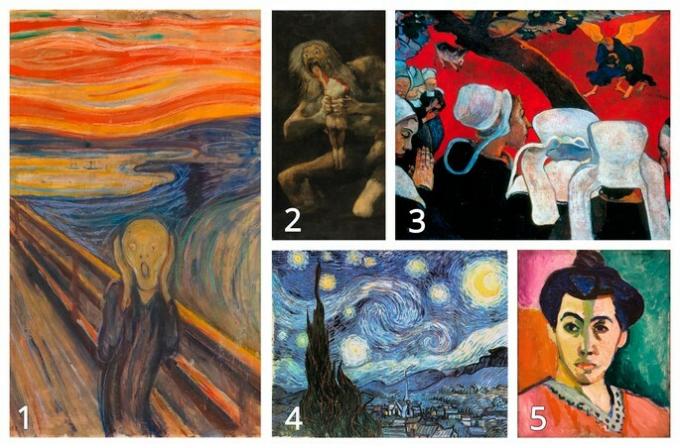
Signs of a critical attitude towards Western modernity had already appeared in the art of the 19th century. Goya and his black paintings had become a reference for German painters, but even more so for Edvard Munch, at the end of that century, considered a forerunner of the movement. The same was influenced by Paul Gauguin and Vincent Van Gogh, as well as the Fauvists and painters Ensor and Emil Nolde.
Towards an expressionist movement

Expressionism was first a pictorial movement that later spread to other disciplines. The first phase was characterized by a satirical vision of the bourgeoisie and a strong yearning for expression. The groups played an important role in promoting the movement. Among them:
- Die Brücke (The bridge): founded in Dresden in 1905 by E. L. Kirchner, E. Heckel and K. Schmidt-Rottluff. Then Emil Nolde, Max Pechstein and Otto Müller joined in.
- Der blaue reiter (The blue rider): formed in Munich around 1911 by the Germans Franz Marc, August Macke and Heinrich Campendonk; the Swiss Paul Klee and the Russian Wassily Kandinsky.
Both groups dissolved in 1913, shortly before the First World War.
- Neue Sachlichkeit (New Objectivity): formed after the First World War by Otto Dix and George Grosz. Its dominant spirit was existential pessimism and satirical and cynical attitude towards society.
In general, the expressionist current in all its manifestations had to suffer the censorship of Nazism, which associated it with communism and considered it subversive.
It may interest you:
- Post-impressionism: the characteristics of it, most important authors and paintings
- 15 avant-garde poems

University professor, singer, Bachelor of Arts (Cultural Promotion mention), Master of Literature Compared by the Central University of Venezuela, and PhD candidate in History at the Autonomous University of Lisbon.

